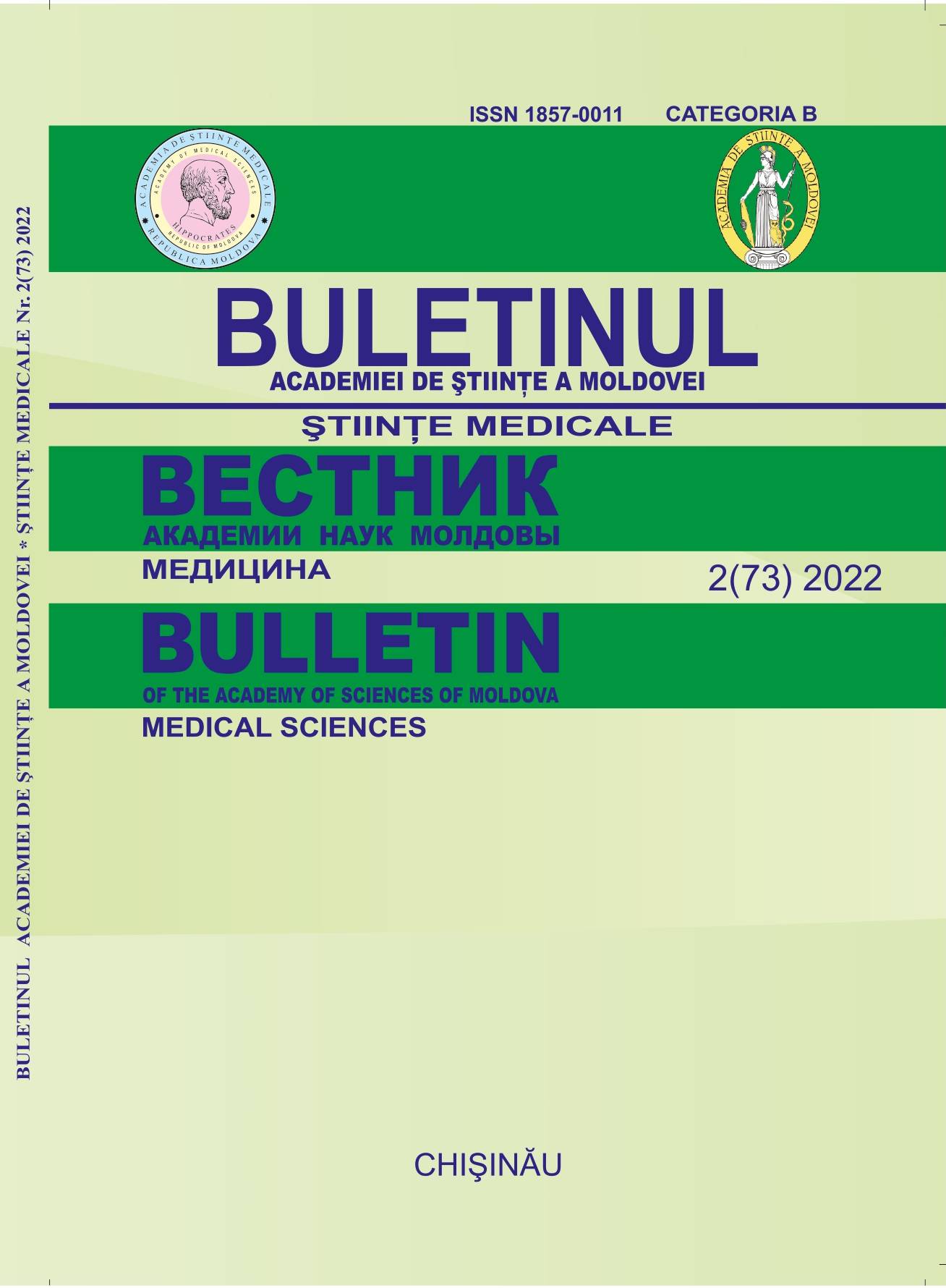В поисках идеального нейромышечного блокатора: обзор литературы
DOI:
https://doi.org/10.52692/1857-0011.2022.2-73.31Ключевые слова:
миорелаксанты, индукция с быстрой последовательной интубацией, кура́реАннотация
Техника современной общей анестезии является многокомпонентной, сбалансированной, с оротрахеальной интубацией, комбинируя препараты, воздействующие на различные рецепторы. Выбор оптимального миорелаксанта для особых обстоятельств в странах с низким доходом остаётся предметом дискуссий. Литературный обзор основан на публикациях в полном формате (n=14), опубликованных за последние 5 лет, отслеживая известные миорелаксанты, так и новые молекулы, испытанные в клинической практике, рассматривая их с точки зрения 10 фармакофизиологических характеристик идеального нервно-мышечного блокатора, а также через цепочку учёта контекстных клинических факторов. Достижения в этой области фармакологии особенно важны, но, похоже, их ещё следует ожидать.
Библиографические ссылки
Donati F. Neuromuscular Blocking Agents. In: Barash P. G., Cahalan M. K., Cullen B. F. et al. Clinical Anesthesia. Philadelphia: LIPPINCOTT WILLIAMS & WILKINS, 2017, 8e.p. 523.
Renew J.R. Clinical use of neuromuscular blocking agents in anesthesia. Up-to-date. 2021. (https://www.uptodate.com/contents/clinical-use-of-neuromuscular-blocking-agents-in anesthesia) (accesat la 08.04.2022).
Lundstrom L., Duez C., Norskov. C. et al. Effects of avoidance or use of neuromuscular blocking agents on outcomes in tracheal intubation: a Cochrane systematic review. British Journal of Anaesthesia. 2018;120(6):1381.
Myatra S. N. Airway management in the critically ill. Current Opinion in Critical Care. 2021; 27(1): 37-45.
Savarese J.J., Kitz R.J. Does clinical anesthesia need new neuromuscular blocking agents? Anesthesiology. 1975;42(3):236-9.
Stäuble C.G..; Blobner M. The future of neuromuscular blocking agents. Current Opinion in Anaesthesiology: 2020; 33(4):490-498.
Thapa S., Brull S.J. Succinylcholine-induced hyperkalemia in patients with renal failure: an old question revisited. Anesth Analg. 2000;91(1):237.
Thürmann P. A. Pharmacodynamics and pharmacokinetics in older adults, Current Opinion in Anaesthesiology. 2020; 33(1):p.109-113.
Wulf H., Ledowski T., Linstedt U. et al. Neuromuscular blocking effects of rocuronium during desflurane, isoflurane, and sevoflurane anaesthesia. Can J Anaesth. 1998;45(6):526.
Yong Beom Kim, Tae-Yun Sung, Hong Seuk Yang. Factors that affect the onset of action of non-depolarizing neuromuscular blocking agents. Korean J Anesthesiol. 2017 Oct;70(5):500-510.
Naguib M., Flood P., McArdle J.J. et al. Advances in neurobiology of the neuromuscular junction: implications for the anesthesiologist. 2002;96(1):202.
Yamauchi M., Takahashi H., Iwasaki H. et al. Respiratory acidosis prolongs, while alkalosis shortens, the duration and recovery time of vecuronium in humans. J Clin Anesth. 2002;14(2):98.
Nigrovic V., Banoub M. Onset of the nondepolarizing neuromuscular block in humans: quantitative aspects. Anesth Analg 1993;76:85-91.
Gouel-Cheron A., Neukirch C., Kantor E. et al. Clinical reasoning in anaphylactic shock: addressing the challenges faced by anaesthesiologists in real time. A clinical review and management algorithms. European Journal of Anaesthesiology. 2021. 38(11):1158-1167.
Garutti I., Errando C., Mazzinari G. et al. Spontaneous recovery of neuromuscular blockade is an independent risk factor for postoperative pulmonary complications after abdominal surgery. European Journal of Anaesthesiology 2020. 37(3): p.203-211.
Tran D.T., Newton E.K., Mount V.A. et al. Rocuronium vs. succinylcholine for rapid sequence intubation: a Cochrane systematic review. Anaesthesia. 2017;72(6):765-777.
Guihard B., Chollet-Xémard Ch., LakhnatiPh. et al. Effect of Rocuronium vs Succinylcholine on Endotracheal Intubation Success Rate Among Patients Undergoing Out-of-Hospital Rapid Sequence Intubation. A Randomized Clinical Trial. JAMA. 2019; 322 (23):2303-2312.
El-Kobbia N., DoghaimM., Abdelaziz M. et al. Comparative study between succinylcholine, rocuronium and magnesium sulphate with rocuronium in rapid sequence induction. Research and opinion in Anesthesia and Intensive Care. 2015. (2):2 57-61.
Heggeri V.M., Harbishettar A.S., Deka A. et al. Intubating Conditions of two Different Doses of Rocuronium At 60 Seconds; by Clinical Assessment; and with T.O.F Response of Adductor Pollicis Muscle. J Clin Diagn Res. 2015;9(9):UC24.
Haiyan S., Tao J., Xiping W. et al. Efficacy of magnesium sulfate as an adjuvant to rocuronium in general anaesthesia: a meta-analysis. Journal of International Medical Research. 2021; 49(7): 1–15.
Choi E.S., Jeong W.J., Ahn S.H. et al. Magnesium sulfate accelerates the onset of low-dose rocuronium in patients undergoing laryngeal microsurgery. J Clin Anesth 2017; 36:102-106.
Soltész S., Fraisl P., Noé K.G. et al. Dexamethasone decreases the duration of rocuronium-induced neuromuscular block: a randomised controlled study. Eur J Anaesthesiol. 2014;31:417–22.
So K. Y., Kim S. H., Jung K. T.eta al. Effect of dexamethasone on the onset time and recovery profiles of cisatracurium. Korean journal of anesthesiology. 2017; 70(2):163–170.
Soltész S., Mencke T., Mey C. et al. Influence of a continuous prednisolone medication on the time course of neuromuscular block of atracurium in patients with chronic inflammatory bowel disease. Br J Anaesth. 2008;100(6):798-802.
Загрузки
Опубликован
Лицензия
Copyright (c) 2022 Вестник Академии Наук Молдовы. Медицина

Это произведение доступно по лицензии Creative Commons «Attribution» («Атрибуция») 4.0 Всемирная.



